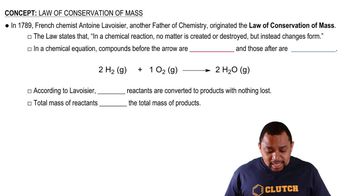Textbook Question
(a) Amonton's law expresses the relationship between pressure and temperature. Use Charles's law and Boyle's law to derive the proportionality relationship between P and T.
939
views

 Verified step by step guidance
Verified step by step guidance


(a) Amonton's law expresses the relationship between pressure and temperature. Use Charles's law and Boyle's law to derive the proportionality relationship between P and T.
(b) If a car tire is filled to a pressure of 220.6 kPa measured at 24 °C, what will be the tire pressure if the tires heat up to 49 °C during driving?
(b) What is the molar volume of an ideal gas at STP?
(c) Room temperature is often assumed to be 25 °C. Calculate the molar volume of an ideal gas at 25 °C and 101.3 kPa pressure.
(d) If you measure pressure in bars instead of atmospheres, calculate the corresponding value of R in L-bar/mol-K.